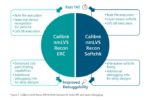Who first came up with this term shift-left ? I’d assumed Siemens EDA as they use it so widely. But their latest white paper on the productivity improvements possible with shift-left Calibre IC verification flows puts the record straight: a software engineer called Larry Smith bagged the naming rights in a 2001 paper (leapfrogging… Read More
Tag: Siemens EDA
Emerging Stronger from the Downturn
It was refreshing to hear a talk focused on emerging stronger from the downturn when the news and media are focused on the gloom. At the recent Siemens EDA User2User conference, Joe Sawicki, executive vice president, IC, gave an uplifting keynote talk to the audience. He highlighted a secular growth trend happening in the semiconductor… Read More
Chiplet Modeling and Workflow Standardization Through CDX
Chiplet is a hot topic in the semiconductor world these days. So much so that if one hasn’t heard that term, the person must be living on a very isolated islet. Humor aside, products built using chiplets-based methodology have been in existence for at least some years now. Companies such as Intel, AMD, Apple and others have integrated… Read More
Tessent SSN Enables Significant Test Time Savings for SoC ATPG
SoC test challenges arise due to the complexity and diversity of the functional blocks integrated into the chip. As SoCs become more complex, it becomes increasingly difficult to access all of the functional blocks within the chip for testing. SoCs also can contain billions of transistors, making it extremely time-consuming… Read More
Achieving Optimal PPA at Placement and Carrying it Through to Signoff
Performance, Power and Area (PPA) metrics are the driving force in the semiconductor market and impact all electronic products that are developed. PPA tradeoff decisions are not engineering decisions, but rather business decisions made by product companies as they decide to enter target end markets. As such, the sooner a company… Read More
Mitigating the Effects of DFE Error Propagation on High-Speed SerDes Links
As digital transmission speeds increase, designers use various techniques to improve the signal-to-noise ratio at the receiver output. One such technique is the Decision Feedback Equalizer (DFE) scheme, commonly used in high-speed Serializer-Deserializer (SerDes) circuits to mitigate the effects of channel noise and … Read More
Building better design flows with tool Open APIs – Calibre RealTime integration shows the way forward
You don’t often hear about the inner workings of EDA tools and flows – the marketing guys much prefer telling us about all the exciting things their tools can do rather than the internal plumbing. But this matters for making design flows – and building these has largely been left to the users to sort out. That’s an increasing challenge… Read More
Calibre: Early Design LVS and ERC Checking gets Interesting
The last thing you want when taping out a design is to hit large numbers of violations in signoff checks that could have been flushed out and resolved in earlier flow iterations. For implementation flows (floorplanning, synthesis, place and route), it’s usual to do a lot of flow flushing work early in the design cycle and iteratively… Read More
Pushing Acceleration to the Edge
As more AI applications turn to edge computing to reduce latencies, the need for more computational performance at the edge continues to increase. However, commodity compute engines don’t have enough compute power or are too power-hungry to meet the needs of edge systems. Thus, when designing AI accelerators for the edge, Joe… Read More











